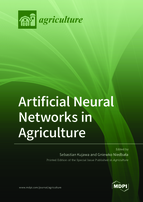Artificial Neural Networks in Agriculture
A special issue of Agriculture (ISSN 2077-0472). This special issue belongs to the section "Agricultural Technology".
Deadline for manuscript submissions: closed (31 December 2020) | Viewed by 105837
Special Issue Editors
Interests: artificial neural networks; artificial intelligence; machine learning; yield modelling; predictions; forecasting; crop production
Special Issues, Collections and Topics in MDPI journals
Interests: artificial neural networks; artificial intelligence; machine learning; yield modelling; predictions; forecasting; crop production
Special Issues, Collections and Topics in MDPI journals
Special Issue Information
Dear Colleagues,
Modern agriculture needs to have high production efficiency combined with a high quality of obtained products. This applies to both crop and livestock production. To meet these requirements, advanced methods of data analysis are more and more frequently used, including those derived from artificial intelligence methods. Artificial neural networks (ANNs) are one of the most popular tools of this kind. They are widely used in solving various classification and prediction tasks, for some time also in the broadly defined field of agriculture. They can form part of precision farming and decision support systems. Artificial neural networks can replace the classical methods of modelling many issues, and are one of the main alternatives to classical mathematical models. The spectrum of applications of artificial neural networks is very wide. For a long time now, researchers from all over the world have been using these tools to support agricultural production, making it more efficient and providing the highest-quality products possible. Therefore, we encourage you to share the results of your research in the area of ANN applications in agriculture and submit your paper to this Special Issue.
Dr. Sebastian Kujawa
Dr. Gniewko Niedbała
Guest Editors
Manuscript Submission Information
Manuscripts should be submitted online at www.mdpi.com by registering and logging in to this website. Once you are registered, click here to go to the submission form. Manuscripts can be submitted until the deadline. All submissions that pass pre-check are peer-reviewed. Accepted papers will be published continuously in the journal (as soon as accepted) and will be listed together on the special issue website. Research articles, review articles as well as short communications are invited. For planned papers, a title and short abstract (about 100 words) can be sent to the Editorial Office for announcement on this website.
Submitted manuscripts should not have been published previously, nor be under consideration for publication elsewhere (except conference proceedings papers). All manuscripts are thoroughly refereed through a single-blind peer-review process. A guide for authors and other relevant information for submission of manuscripts is available on the Instructions for Authors page. Agriculture is an international peer-reviewed open access monthly journal published by MDPI.
Please visit the Instructions for Authors page before submitting a manuscript. The Article Processing Charge (APC) for publication in this open access journal is 2600 CHF (Swiss Francs). Submitted papers should be well formatted and use good English. Authors may use MDPI's English editing service prior to publication or during author revisions.
Keywords
- ANNs in agriculture
- plant and livestock monitoring
- plant diseases and damages
- plant growth
- yield prediction
- crop classification
- crop quality assessment
- crop models
- cropping systems
- soil and plant nutrition
- soil fertility management
- automated harvesting
- irrigation systems
- agrometeorological models
- model application for sustainable agriculture
- precision agriculture
- remote sensing for agriculture
- decision supporting systems
- neural image analysis
- convolutional neural networks
- other agricultural topics (with the use of ANN)







